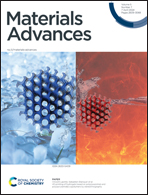A robust and high performance copper silicide catalyst for electrochemical CO2 reduction†
Abstract
A copper-based catalyst CuxSi (3 < x < 5) was prepared using chemical vapor deposition (CVD) of butylsilane (BuSiH3) on copper substrates. By varying the precursor flow, we obtained two catalyst variants, one with and one without a SiCx shell. Both variants exhibited large specific areas, owing to the presence of grown nanostructures such as nanoplatelets, nanowires, nanoribbons, and microwires. Remarkably, the catalytic performance of both variants remained stable even after 720 hours of continuous operation. The porous and thick catalyst layer (over a hundred micrometers) on the substrate significantly increased the residence time of intermediates during the electrochemical CO2 reduction reactions (eCO2RR). We observed a high selectivity towards ethanol (∼79%) in neutral CO2-saturated electrolytes and a high selectivity towards acetic acid (∼72%) in alkaline electrolytes. Importantly, the ratio between generated ethanol and acetate could be shifted by adjusting the pH and applied potential. This work thus establishes copper silicides as robust and promising electrocatalysts for selective CO2 conversion to high-value multi-carbon products.



 Please wait while we load your content...
Please wait while we load your content...